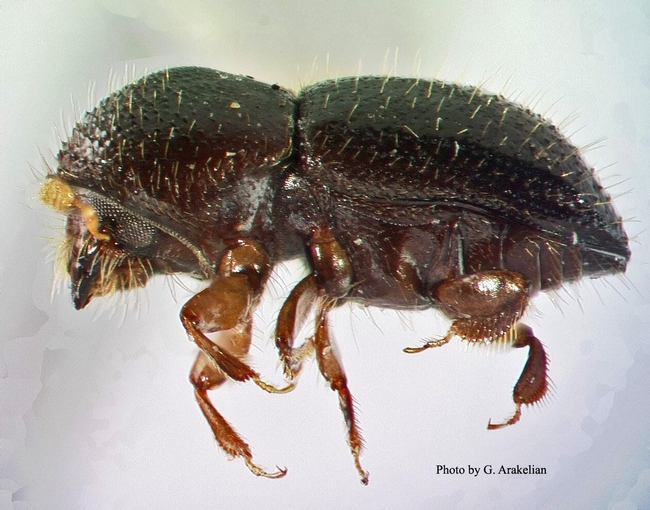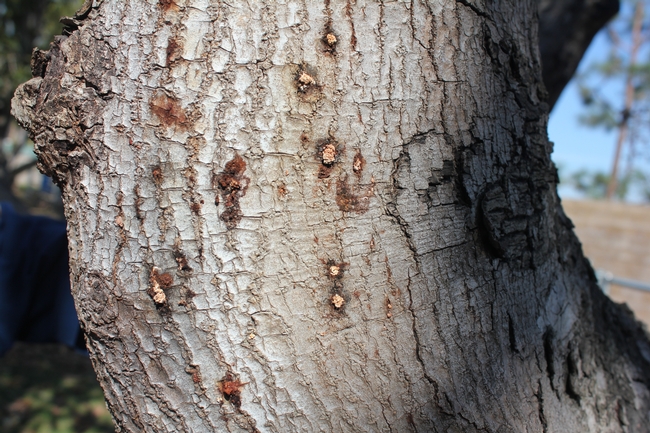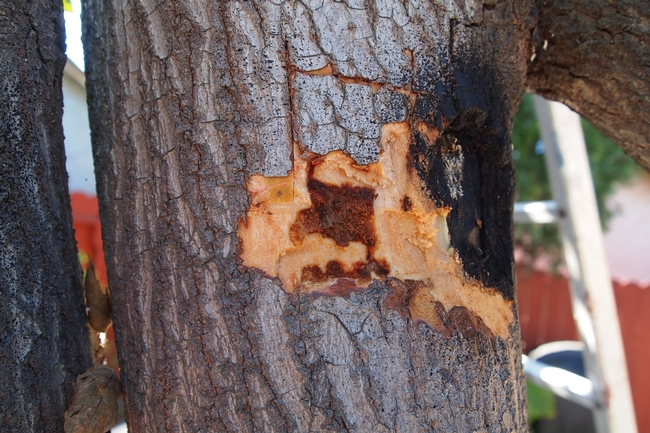Watch out for these insects! Invasive shot hole borers (ISHB) represent two related species of beetles (polyphagous and Kuroshio) in the genus Euwallacea. Both spread fusarium dieback, a disease that restricts the flow of water and nutrients in the tree, resulting in dead branches, dropped limbs, and even death. Over 60 species of native and non-native ornamental trees and avocados in Southern California are susceptible the ISHB/fusarium dieback complex.Examples of known hosts of the ISHB/fusarium dieback complex include: Box Elder (Acer negundo), Avocado (Persea americana), English Oak (Quercus robur), Valley Oak (Quercus lobata), California coast live oak (Quercus agrifolia), Big leaf maple (Acer macrophyhllum) silk tree (Albizia julibrissin) Liquidambar (Liquidambar styraciflua), Coral tree (Erythrina coralladendron), California sycamore (Platanus racemose), Blue Palo Verde (Cercidium floridum), Purple orchid tree (Bauhinia variegate), Kurrajong (Brachychiton populneus); and many species of Acacia.
The beetles are native to Southeast Asia and were likely introduced into California in shipped goods, wood products, or packaging. While tiny (about the size of a sesame seed), they are prolific, tunneling into host trees and living and reproducing in galleries while feasting on the disease-causing fungus they spread from tree to tree. Females are black and much more common than the small wingless brown males, which are rarely found.

While the initial infestation occurred in Los Angeles County in 2003, beetles travel about 12 miles a year and have now spread fusarium dieback into Orange, San Diego, Riverside, San Bernardino, Ventura, and Santa Barbara Counties. Orange County alone has spent millions of dollars removing infested trees and managing the spread of the ISHB/fusarium dieback complex.
Identifying ISHB in a timely way is essential to reduce damage and slow its spread. Look for round borer entry holes about the size of the tip of a medium ballpoint pen. Staining, gumming, discoloration of wood beneath the bark, and/or frass (sawdust-like material) are other common signs and symptoms. There may also be white powdery exudate around beetle entry holes. Keep in mind that there are many other disorders that have similar symptoms. For example, other fungal diseases produce exudate and staining and other types of borers leave entry holes of various shapes and sizes.


To date, no effective control measures have been found once trees are infested, although entomologists and plant pathologists from the University of California, The USDA Forest Service and other agencies continue to research viable integrated pest management options including biological control.
To prevent and/or reduce spread of ISHB/fusarium dieback:
- Bring only ISHB-free greenwaste (used for mulch and soil amendments) and firewood onsite. Both products can harbor ISHB which can persist for months.
- Treat infected wood onsite whenever possible. Wrap or completely cover wood that cannot be immediately treated and wood that is moved offsite for treatment elsewhere.
- Chipping infested wood to 1 inch or less can kill 95% of the beetles, while solarizing it using a clear tarp eliminates both ISHB and spores produced by the fungus. Logs can also be solarized. Composting is another option that, when done correctly, can kill both beetles and fungal spores.
- Untreated logs, branches, or woodchips infested with ISHB should not be used for firewood or mulch.
- Remove stumps as well as dead trees.
- Follow International Society of Arboriculture pruning standards and never top or flush cut trees which leave open wounds.
- Spray a 70% ethanol solution on equipment and tools since fusarium fungi can adhere to both.
- Keep trees healthy (water mature trees deeply and infrequently, avoid over or under-fertilization, etc.).
- Monitor susceptible tree species often to identify damage as early as possible. Useful detection and reporting tools and more detailed information on the ISHB/fusarium dieback complex can be found here: ucanr.edu/sites/pshb
For more detailed information on the ISHB/fusarium dieback complex, please visit these websites: https://ucanr.edu/sites/pshb/ https://www2.ipm.ucanr.edu/agriculture/avocado/polyphagous-shot-hole-borer-and-kuroshio-shot-hole-borer/ https://cisr.ucr.edu/invasive-species/polyphagous-shot-hole-borer https://californiareleaf.org/pests/